Not that they’re ugly. They’re not. But they get such a bad rap because of their nest parasitism habit, most folks (including bird photographers) don’t give them a chance.
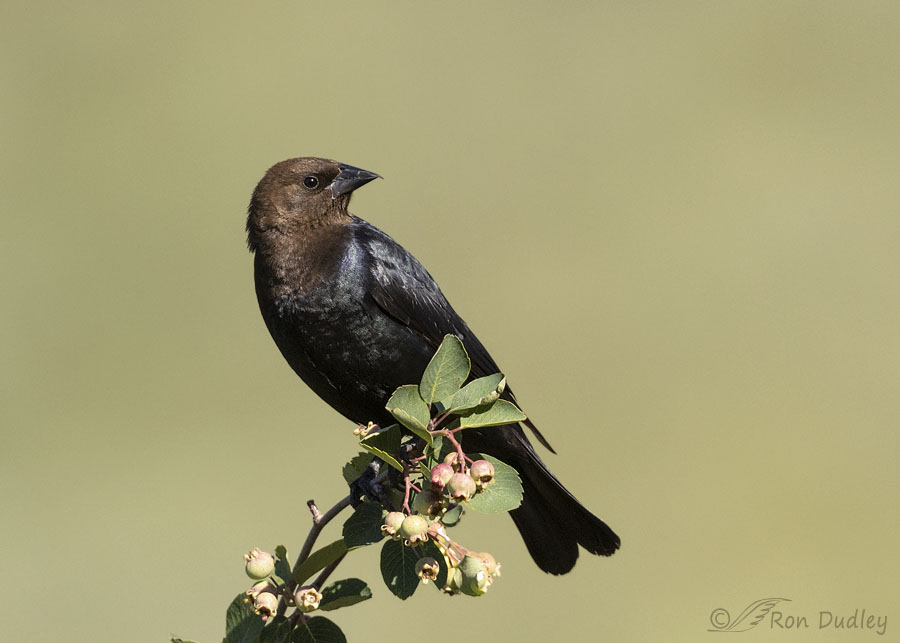
1/5000, f/5.6, ISO 800, Canon R5, Canon EF500mm f/4L IS II USM + 1.4 tc, not baited, set up or called in
Yesterday morning in the mountains I couldn’t resist photographing this cooperative male Brown-headed Cowbird. He was in pretty good light, he was close and I thought his serviceberry perch was attractive. I had a clean look at him and the greenish mountainside in the background provided some nice color.
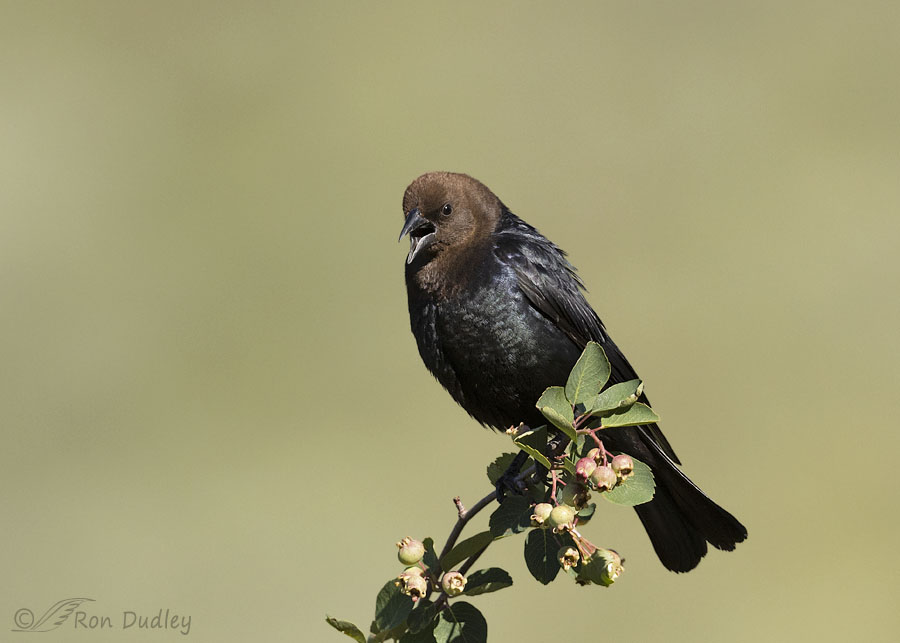
1/4000, f/5.6, ISO 800, Canon R5, Canon EF500mm f/4L IS II USM + 1.4 tc, not baited, set up or called in
Intermittently he was “singing” (if you want to call it that) one of their several typical songs that has been described as sounding like “glug glug glee“. Personally, I found his singing pose to be more interesting than his actual song.
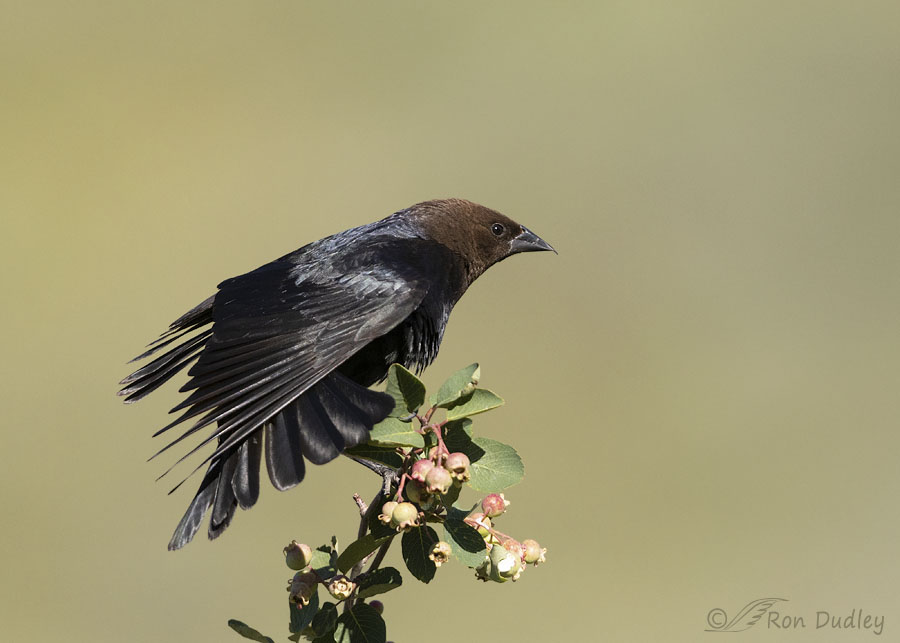
1/5000, f/5.6, ISO 800, Canon R5, Canon EF500mm f/4L IS II USM + 1.4 tc, not baited, set up or called in
At one point he performed a wing and tail stretch but he refused to give me eye contact during the entire long and drawn-out process. This pose was followed by…
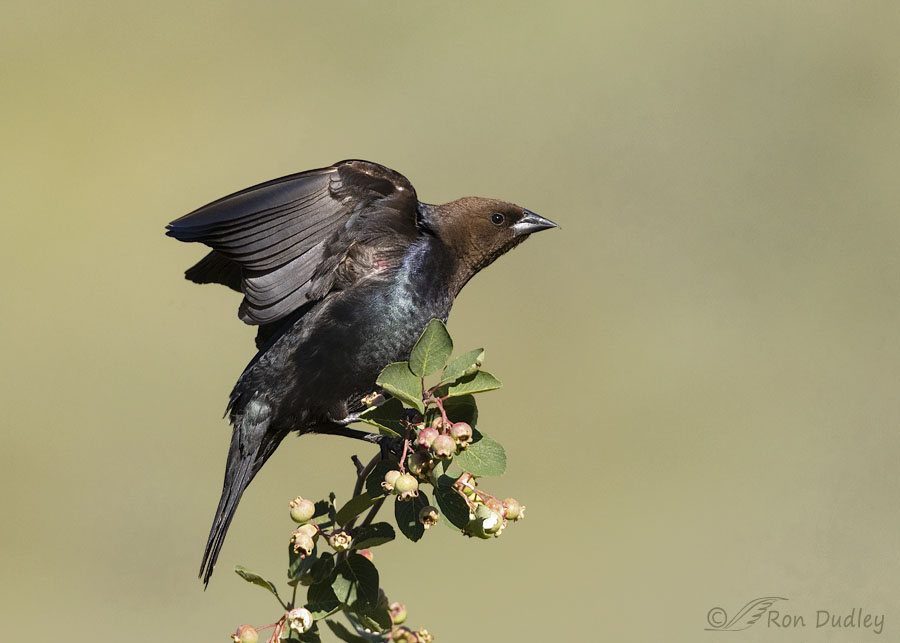
1/5000, f/5.6, ISO 800, Canon R5, Canon EF500mm f/4L IS II USM + 1.4 tc, not baited, set up or called in
a vertical wing stretch with more of a head turn and better eye contact.
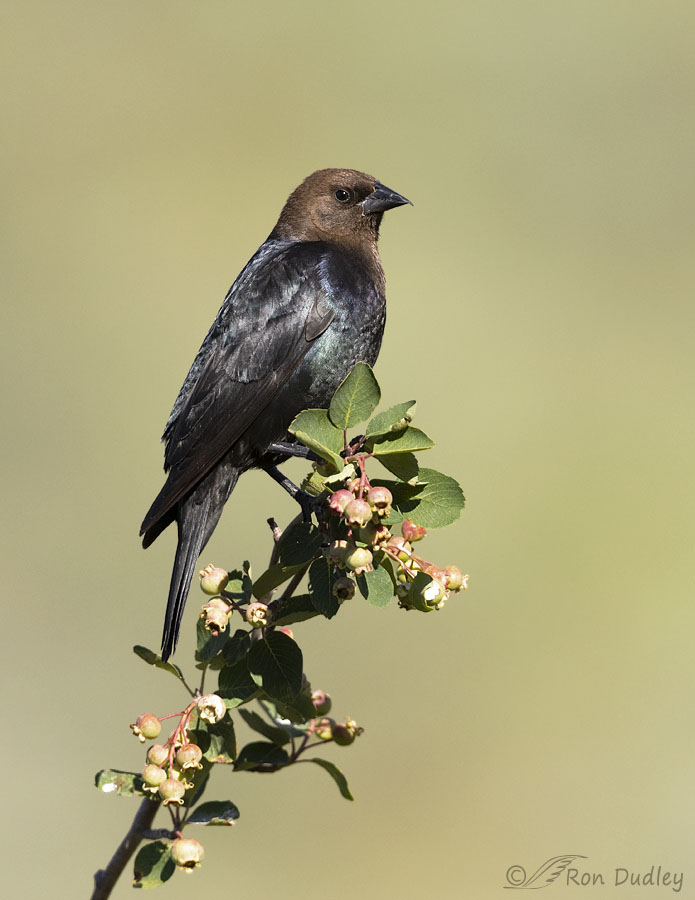
1/4000, f/5.6, ISO 800, Canon R5, Canon EF500mm f/4L IS II USM + 1.4 tc, not baited, set up or called in
But I think he looked best with a vertical composition that included more of the serviceberries to dress him up a little. My camera settings were designed for takeoff and flight shots but after spending almost twelve minutes with him he never even hinted at taking off so I drove on down the road to look for other birds.
I’m glad I stopped for him – these are some of the better cowbird photos I’ve taken. But I’ll admit, that might be due in part to the fact that I tend to ignore cowbirds more often than I do other species.
Ron
PS:
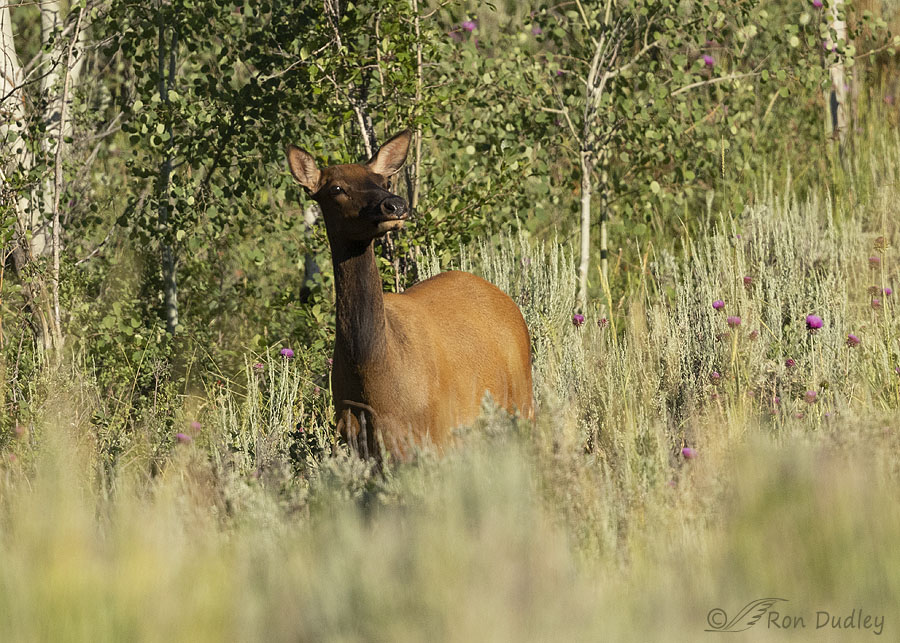
For those who aren’t cowbird fans, I’ll close with a photo of an elk that came in fairly close to me a few minutes earlier while I was photographing other birds. There were at least three elk beginning to come out into the open but immediately after this photo was taken they were scared back into the aspens by a man walking his dog. For some reason my photos of them weren’t very sharp but they document their appearance.


Your outstanding photographs and apt comments reinforce my desire to capture images of the “more common” birds that are too often passed over by the professionals.
I always stop for a gaggle of cowbirds as there is great potential for some of the “uncommon” relatives to hide within the flock.
You’re right about the uncommon relatives, Wally
Arwen, European cuckoos are nest parasites, N. American cuckoos are not. I can’t bear to see roadrunners or yellow billed cuckoos maligned. Cowbirds fill that niche here.
Elizabeth, Arwen is correct. Yellow-billed Cuckoos are occasional brood (nest) parasites. Here’s what Cornell’s Birds of the World says about brood parasitism in Yellow-billed Cuckoos.
“Intraspecific brood parasite that occasionally lays eggs in other Yellow-billed Cuckoo nests. Also occasional interspecific brood parasite. Known to parasitize at least 11 other bird species.”
Thanks for the clarification, Ron.
Those gorgeous, shiny browns and blacks! You’ve definitely given this bird his due! And an elk bonus shot!
Thanks, Marty. In the right light those shiny blacks show up pretty well.
The last shot gives him personality. I like Dan’s take on best parasitism. Cuckoos do this but most often we love them…
I like Dan’s take on best parasitism. Cuckoos do this but most often we love them…
Arwen, I like Dan’s take on most everything.
I particularly liked the last shot of the cowbird and was fascinated by reading Dan’s comments about the ‘why’ of the behaviour we find so distasteful. Thank you both.
Dan always adds interesting stuff. Thanks, EC.
Mission accomplished.
Good.
Wonderful photos! I love the light pose and colors. I like cowbirds, I think their iridescent feathers are beautiful. They have such a mechanical song. We had one we raised early on in Haley’s rehabbing. He was so funny he would display and try to mate with Haley’s old black flip phone. It is amazing how they still know they are a cowbird. Hard wiring.
April, one guy on Facebook said he likes their song because he thinks it sounds like “trickling water”. With all the coffee I drink that would just make me have to pee all the time…
I’m glad Dan chimed in here on the Cowbird’s biological imperative, as it were. I read a great thread on Twitter just yesterday about this very thing, so I have at least a better understanding, if not an appreciation, of their behaviors. Though I wonder, why not Bisonbird instead of Cowbird? Your photos do highlight their feathered “assets” … the vertical crop with extra serviceberries and gorgeous background is my favorite! (Love the beautiful elk, too.)
Your photos do highlight their feathered “assets” … the vertical crop with extra serviceberries and gorgeous background is my favorite! (Love the beautiful elk, too.)
“why not Bisonbird instead of Cowbird?”
Chris, I suppose it’s a matter of when the name took hold. A related thought: would they have named it bisonbird or buffalabird?
Which brings Antelope Island to mind, since their proper name is pronghorn not antelope. But somehow Pronghorn Island just doesn’t have the same ring to it.
As an aside, for a time another bird had buffalo in its name. With the shaggy appearance off this ducks head it became the Buffalo-headed Duck. But the name didn’t stick and was shortened to what we know today as Bufflehead.
Now that I did not know!
Damn Ron, you succeeded in making this Brown-headed Cowbird look very good. I think best Cowbird photos I have ever seen. Often I have seen a bird early am and started focusing in and then said – damn it just a Cowbird and did not even take the photo. I have taken photos though, but none even close to these. I think the photos I most enjoyed taking of one though was seeing it standing on a Warbler’s nest while his faux mom looked on.
Thanks very much, Everett. I think they’re pretty good cowbird photos too.
Great photos of a bird I rather enjoy. I know I’m in the minority but it’s a native North American species with a fascinating behavior. Originally a prairie species, it has expanded its range far beyond because of the habitat clearing we have done, so it now impacts species that were not originally hosts. They follow bison and gather the insects stirred up by their feet. But bison wander long distances which makes it impossible to follow them and maintain a nest. The solution is to not build a nest and let other raise your young. Brood parasitism is a fascinating behavior and takes many forms around the world. We too often judge nature by our values and in doing so, develop distorted views of some species. Most people love Redheads. They are a beautiful duck. Yet, more than half of the time they are brood parasites on other ducks, especially Canvasbacks. But we seem to judge them differently than cowbirds. There are some species severely impacted by cowbirds but those species were not species originally hosting cowbirds until we changed the environment.
Thanks for explaining all that, Dan. I’ve always thought the part about the bison was fascinating.
Thanks for filling in the details, Dan. I always learn something from here- sometimes from Ron, but often from his followers!
I suppose we must hold harmless the male as to the charge of brood parasitism, although he indirectly abets the practice via mating with the female.
This fellow seems to have a rather long upper mandible (interesting that BotW refers to it as the maxilla).
I think you have caught his feather iridescence as much as I ever see it; it’s there but not as impressive as, say, in your photos of Magpies.
The serviceberries in my yard are fully ripe, but then I’m close to sea level.
Very nice photo of the elk among the (I think) thistles. Good name for a pub: Elk and Thistle.
“interesting that BotW refers to it as the maxilla”
Lyle, I see it said both ways but most often it seems to be upper mandible. Which goes against the grain for this biologist but I’ve stopped fighting it.
Beautiful bird IF one can get past their “egg sucking habits” so to speak……
Elk sure has a beautiful, red, coat!
Judy, all three were that same color.
Beautiful photos, Ron, but I cringe every time I see one. From an evolutionary perspective, they’ve got a great thing going. Why raise your young when you can get another bird to do it for you? But it’s absolutely soul-crushing when I see a Wood Thrush, Scarlet Tanager or White-eyed Vireo feeding a Cowbird fledge. Add Northern Cardinal and Song Sparrow, and you’ll have the complete list of species feeding Cowbirds that I’ve seen so far this summer. Sigh….
I know, it’s hard to see. But then so is seeing a raptor tearing apart the same birds, or raiding their nests, and we don’t feel the same way about them.
Nothing we can do about ’em except enjoy what they do have to offer. Still, thanks for the elk, too.
You’re welcome, Cheryl.
I REALLY LIKED the last cowbird shot– not only because of the long serviceberry branch–a graceful and colorful perch– but also because the angle of the light delineated the feather groupings
so beautifully– I think it’s a truly elegant composition !
I agree, Kris – that’s my favorite one too.
Really nice photos, Ron, of a persona non grata!
But I myself like watching cowbirds! Am I the only one? Their colors are beautiful in the sunlight (as you have captured) and their courting habits in the spring are lively and amusing!
Joanne, I doubt you’re the only one but I suspect we’re in the minority.
As the saying goes, “You can’t make a silk purse out of a pig’s ear,” but I must admit that I like the aesthetics and the varied postures of the cowbird.
Thank you, Ken.